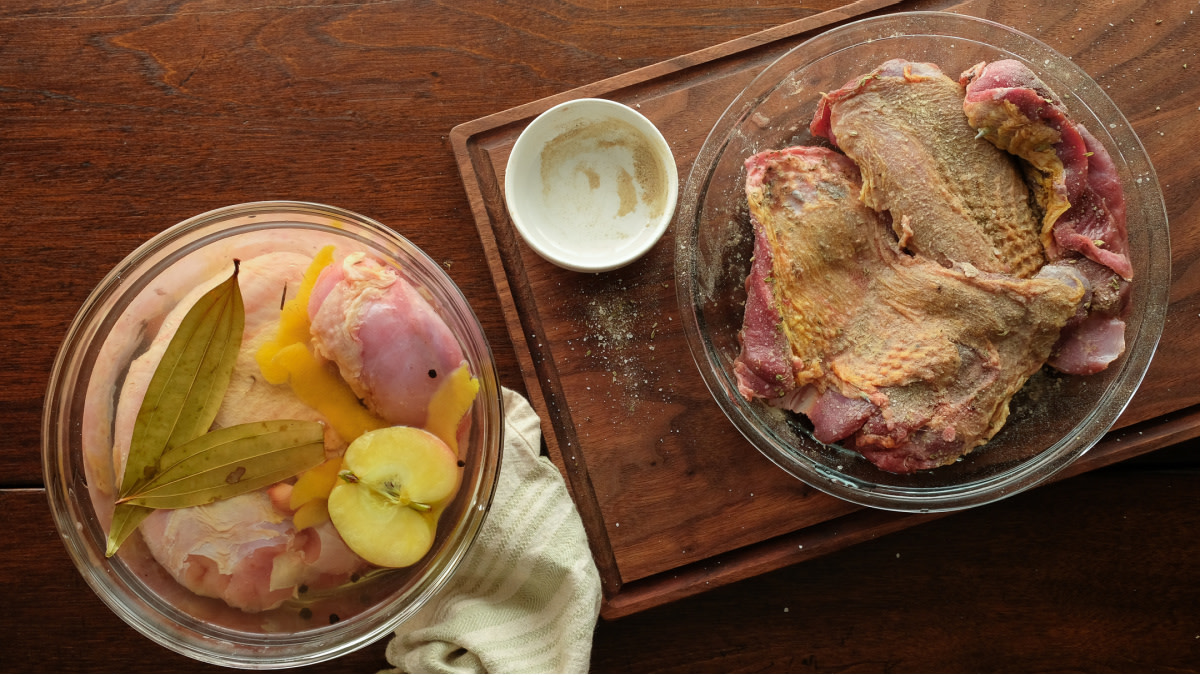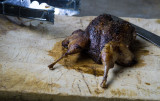
There are as many turkey brine recipes as there are ways to shock gobble a tom. The key to the technique is understanding how brines work and a few things to avoid.
Brining is simply infusing a protein with salt, which seasons the meat internally, helps it to retain moisture, and firms up the texture. Since turkey is so lean, this process makes up for the lack of fat and helps to keep the meat moist. That allows you to cook it to the desired internal temperature without drying out the meat.
There are two basic methods for brining: wet and dry. As the names suggest, one involves a liquid while the other does not. They both achieve the same goal of introducing salt and added flavors, but the methods differ greatly.
Wet Brine for Turkey
This is the most flexible way to brine a turkey. Using a liquid as your base, you can add in just about anything you want to impart additional flavors such as spices, herbs, and other aromatics. That being said, there are a few things to keep in mind. The salt-to-water ratio is the most important part of a wet brine. Too much and it’ll be too salty, too little and the turkey won’t absorb enough salt to make the brine worth your effort. A good rule of thumb is 1 cup of salt to 1 gallon of water.
One thing to avoid is making a brine that’s too high in acid. Acid will denature the proteins (think ceviche), which will prevent the meat from absorbing the salt and will change the texture of the meat for the worse. Soda is highly acidic, so avoid using it in your brines.
Below is a wet turkey brine recipe I've used for years. It’s simple and neutral in flavor. The fruit compliments the mild meat without overpowering and allows the turkey to be prepared in any way without conflicting flavors. Roast, bake, broil, fry, or smoke after a 12- to 24-hour soak.
Wet Brine Ingredients
- 1 gallon water
- 1 cup salt
- 1/2 cup white sugar
- 2-3 bay leaves
- 1 sweet apple, halved
- 4 cloves garlic
- 2 tbsp. black peppercorn
- Zest of half a lemon
Method
Combine all ingredients and bring to a simmer, stirring until salt and sugars are dissolved. Allow it to cool completely (to around 40°F) before submerging turkey in brine. Adding the turkey while the brine is warm will partially cook the surface of the meat, which prevents proper absorption of salt and liquid. If you want the brine ready to use immediately, only pour in a portion of the water to dissolve the salt and sugar, then top off with ice until you have a gallon of liquid.
Brine for 12 to 24 hours. This is a concentrated salt brine with about 7% salt. Leaving the turkey in the brine too long will result in excessively salty meat.
Dry Brine for Turkey
Dry brines essentially do the same thing as wet brines without the medium of a liquid. The best way to achieve this is by using an equilibrium brine. That requires a precise amount of salt to season the meat without curing it, which will actually draw liquid out of the meat. Generally speaking, the perfect amount of salt in a dry brine is 1.5% to 1.75% by weight.
You want the brine to have enough time to penetrate throughout the meat. Unlike concentrated brines (like the previously discussed wet brine) with high sodium ratios, this method only adds the ideal amount of salt, so you don’t have to worry about the turkey getting too oceanic if it brines longer than intended.
I find that dry brining works best for turkey that I plan on cooking with liquids, such as any recipe that calls for a braise or stew. I use this dry brine for turkey breasts, thighs, and legs that are destined for the Dutch oven or crockpot.
Dry Brine Ingredients
- 1.5% salt to weight of turkey meat (~1 tsp. per pound)
- 0.75% white sugar (~1 tsp. per pound)
- 0.25% oregano, dried (~1 tsp. per pound)
- 0.5% white pepper, ground (~1 tsp. per pound)
Method
To properly dry brine a turkey, you need a scale. Weigh the meat you are brining, then estimate and subtract the weight of the bones if present. Next, measure out 1.5% of that weight in salt. Just like with wet brines, additional ingredients like citrus zest, dried herbs, or sugar can add flavor to the meat.
Mix ingredients together. Pat the turkey meat dry, then evenly coat the exterior of the meat with the brine mixture. Vac seal, place in a Ziploc bag, or cover in a non-reactive container in a refrigerator for 16 to 36 hours. Because the amount of salt used is the ideal sodium content, you don’t have to worry about over-brining. The meat will only absorb the amount of salt in the brine and will not end up excessively salty, even if you forget about it for an extra day or two.






